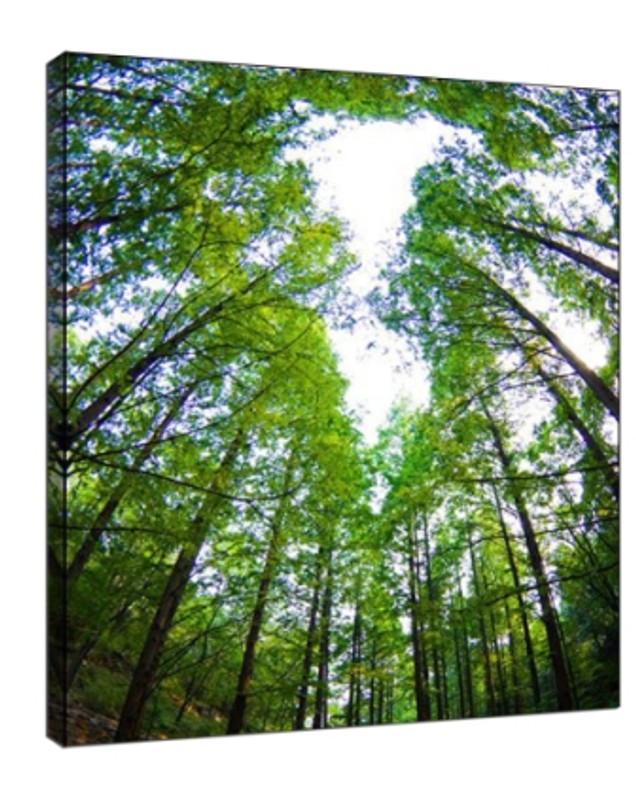Creative composition of nature photography
Different from frame composition created by man-made objects such as window frames, frame composition in landscape photography refers to the use of natural scenery as the foreground to frame the subject of the picture. Frame composition can guide the viewer's line of sight and make the subject more prominent in the picture. The framing style tests the photographer's eye. When shooting, if you want to compose a frame with messy natural elements, you must make use of reasonable framing and perspective relationship. Elements that seem impossible to frame, such as cluttered branches and leaves, can be appropriately selected as tools for framing. When framing, pay special attention to exposure techniques, as the color and lighting conditions of the subject inside and outside the frame can be completely different. At this point, the main body of the picture should be taken as the metering object.
[Adverse performance]
Landscape photography is a choice of limited subjects in the vast space of nature. During shooting, the photographer selects the close shot, medium shot and distant shot through the method of composition to highlight the subject of the picture. Due to the influence of similar shooting subjects and conventional thinking, film friends are often constrained when choosing the main body of the picture. The elements with bright colors and beautiful shapes are often the best choice for the main body of the picture. If we change the Angle and adopt the way of reverse thinking, we will find that many subjects who are not beautiful on the surface can also express special emotions. For example, in the photo in this case, the photographer takes the dry forest as the subject and USES the background rocks to set off the neat and upright state of the dry forest, showing the diversity of plants in nature and the differences in their growth rules.
[Create visual impact]
For visually bland subjects, the photographer can change the focal length of the lens and use a unique shooting Angle to enhance the visual impact of the photo. The perspective effect of a wide-angle lens can enhance the visual impact of the picture, in the same way, shooting with a fish-eye lens can further create an exaggerated visual effect. In this case, the photographer used a low-angle upshot combined with a fish-eye lens to photograph the woods. The unique perspective deformation of the lens makes the trees converge towards the center point, almost covering the sky, showing the tall and luxuriant trees and achieving the ideal effect.
[Create picture Rhythm]
In landscape photography, the relationship between the weight of picture elements and the looseness and closeness of the overall effect are inseparable from the photographer's control of rhythm. Visually, through the arrangement of shapes, lines, positions and proportions similar to natural elements, the picture can show a sense of rhythm. The rhythm of landscape photographs is also inseparable from the overall grasp of light and color. The ingenious arrangement of elements with the same or similar attributes can make the viewer leap in thought and progressive in emotion when viewing the photos. In this case, the photographer used the compression effect of the telephoto lens to create a rhythmic image, showing the tenacious vitality of polar penguins.

[Combination of various composition techniques]
There are many composition skills in landscape photography, and you can combine them to achieve the most ideal effect. In this case, the photographer used the principle of light reflection to capture the reflection of the lake and the reflection of the water surface to reverse the rich colors of autumn. This kind of shooting can be figurative or abstract, the difference is whether the water is still or not. When the water surface is still, the details of reflection can be represented concretely. When the water surface fluctuates, the dynamic effect of reflection can be abstractly presented. Light reflects and refracts both when it hits the water, and photographers can use a polarizing lens to control the reflection and clarity of objects in the water. The photo in this example also USES color contrast.
The calm lake's deep blue color contrasts with the reflected golden trees, adding color to the picture. The performance effect of this kind of color can be further strengthened through post processing. A single shot of the reflection in the water often leads to a lack of stereoscopic effect. For this reason, the photographer also included the grass by the lake in the composition, making it the foreground of the picture. At the same time, a backlit tree is included to form an obvious dark area in the picture, which enhances the contrast between light and dark and the sense of weight. At the same time, a stable and balanced visual effect is achieved on the left and right sides of the picture. In landscape creation, the photographer can also choose square, 3∶2 or 16∶9 to create according to the characteristics of the landscape. Even if the composition cannot be done properly due to the limitations of the camera, it is still possible to make the composition of the picture present the best effect through post-cropping.
Recent Posts
-
How to Print Photo on Canvas
Have you ever wanted to transform a cherished photograph into stunning wall art? Printing your photo …22nd Apr 2025 -
Why Perspex Sheets Are Ideal for High-Quality Digital Prints
In the world of modern printing, perspex printing has become an increasingly popular choice for high …17th Apr 2025 -
Top 5 Benefits of Using Custom Ceramic Coasters Over Other Materials
When it comes to protecting your furniture from water rings, spills, and stains, coasters are essent …17th Apr 2025
